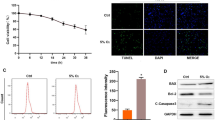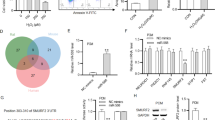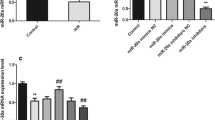Abstract
Acute coronary artery blockage leads to acute myocardial infarction (AMI). Cardiomyocytes are terminally differentiated cells that rarely divide. Treatments preventing cardiomyocyte loss during AMI have a high therapeutic benefit. Accumulating evidence shows that microRNAs (miRNAs) may play an essential role in cardiovascular diseases. This study aims to explore the biological function and underlying regulatory molecular mechanism of miR-322-5p on myocardial infarction (MI). This study's miR-322-5p is downregulated in MI-injured hearts according to integrative bioinformatics and experimental analyses. In the MI rat model, miR-322-5p overexpression partially eliminated MI-induced changes in myocardial enzymes and oxidative stress markers, improved MI-caused impairment on cardiac functions, inhibited myocardial apoptosis, attenuated MI-caused alterations in TGF-β, p-Smad2, p-Smad4, and Smad7 protein levels. In oxygen–glucose deprivation (OGD)-injured H9c2 cells, miR-322-5p overexpression partially rescued OGD-inhibited cell viability and attenuated OGD-caused alterations in the TGF-β/Smad signaling. miR-322-5p directly targeted Smurf2 and inhibited Smurf2 expression. In OGD-injured H9c2 cells, Smurf2 knockdown exerted similar effects to miR-322-5p overexpression upon cell viability and TGF-β/Smad signaling; moreover, Smurf2 knockdown partially attenuated miR-322-5p inhibition effects on OGD-injured H9c2 cells. In conclusion, miR-322-5p is downregulated in MI rat heart and OGD-stimulated rat cardiomyocytes; the miR-322-5p/Smurf2 axis improves OGD-inhibited cardiomyocyte cell viability and MI-induced cardiac injuries and dysfunction through the TGF-β/Smad signaling.






Similar content being viewed by others
Data availability
The authors confirm that the data supporting the findings of this study are available within the article.
References
Liang H, Su X, Wu Q, et al. LncRNA 2810403D21Rik/Mirf promotes ischemic myocardial injury by regulating autophagy through targeting Mir26a. Autophagy. 2020;16:1077–91.
Qian L, Van Laake LW, Huang Y, Liu S, Wendland MF, Srivastava D. miR-24 inhibits apoptosis and represses Bim in mouse cardiomyocytes. J Exp Med. 2011;208:549–60.
Orogo AM, Gustafsson AB. Cell death in the myocardium: my heart won’t go on. IUBMB Life. 2013;65:651–6.
Saadat S, Noureddini M, Mahjoubin-Tehran M, et al. Pivotal role of TGF-beta/Smad signaling in cardiac fibrosis: non-coding RNAs as effectual players. Front Cardiovasc Med. 2020;7:588347.
Dzialo E, Tkacz K, Blyszczuk P. Crosstalk between the TGF-beta and WNT signalling pathways during cardiac fibrogenesis. Acta Biochim Pol. 2018;65:341–9.
Park S, Nguyen NB, Pezhouman A, Ardehali R. Cardiac fibrosis: potential therapeutic targets. Transl Res. 2019;209:121–37.
Li X, Zhang ZL, Wang HF. Fusaric acid (FA) protects heart failure induced by isoproterenol (ISP) in mice through fibrosis prevention via TGF-beta1/SMADs and PI3K/AKT signaling pathways. Biomed Pharmacother. 2017;93:130–45.
Leask A, Abraham DJ. TGF-beta signaling and the fibrotic response. FASEB J. 2004;18:816–27.
Ikeuchi M, Tsutsui H, Shiomi T, et al. Inhibition of TGF-beta signaling exacerbates early cardiac dysfunction but prevents late remodeling after infarction. Cardiovasc Res. 2004;64:526–35.
Park SH. Fine tuning and cross-talking of TGF-beta signal by inhibitory Smads. J Biochem Mol Biol. 2005;38:9–16.
Mattick JS, Makunin V. Non-coding RNA. Hum Mol Genet. 2006;15:17–29.
Xiao Y, Zhao J, Tuazon JP, Borlongan CV, Yu G. MicroRNA-133a and myocardial infarction. Cell Transplant. 2019;28:831–8.
Cruz MS, da Silva AMG, de Souza KSC, Luchessi AD, Silbiger VN. miRNAs emerge as circulating biomarkers of post-myocardial infarction heart failure. Heart Fail Rev. 2020;25:321–9.
Wojciechowska A, Braniewska A, Kozar-Kaminska K. MicroRNA in cardiovascular biology and disease. Adv Clin Exp Med. 2017;26:865–74.
Wang GK, Zhu JQ, Zhang JT, et al. Circulating microRNA: a novel potential biomarker for early diagnosis of acute myocardial infarction in humans. Eur Heart J. 2010;31:659–66.
Ai J, Zhang R, Li Y, et al. Circulating microRNA-1 as a potential novel biomarker for acute myocardial infarction. Biochem Biophys Res Commun. 2010;391:73–7.
Yang B, Lin H, Xiao J, et al. The muscle-specific microRNA miR-1 regulates cardiac arrhythmogenic potential by targeting GJA1 and KCNJ2. Nat Med. 2007;13:486–91.
Luo X, Pan Z, Shan H, et al. MicroRNA-26 governs profibrillatory inward-rectifier potassium current changes in atrial fibrillation. J Clin Invest. 2013;123:1939–51.
Liu Y, Wang Z, Xiao W. MicroRNA-26a protects against cardiac hypertrophy via inhibiting GATA4 in rat model and cultured cardiomyocytes. Mol Med Rep. 2016;14:2860–6.
Zhang Y, Qin W, Zhang L, et al. MicroRNA-26a prevents endothelial cell apoptosis by directly targeting TRPC6 in the setting of atherosclerosis. Sci Rep. 2015;5:9401.
Ren XP, Wu J, Wang X, et al. MicroRNA-320 is involved in the regulation of cardiac ischemia/reperfusion injury by targeting heat-shock protein 20. Circulation. 2009;119:2357–66.
van Rooij E, Sutherland LB, Thatcher JE, et al. Dysregulation of microRNAs after myocardial infarction reveals a role of miR-29 in cardiac fibrosis. Proc Natl Acad Sci U S A. 2008;105:13027–32.
Rane S, He M, Sayed D, et al. Downregulation of miR-199a derepresses hypoxia-inducible factor-1alpha and Sirtuin 1 and recapitulates hypoxia preconditioning in cardiac myocytes. Circ Res. 2009;104:879–86.
Atri C, Guerfali FZ, Laouini D (2019) MicroRNAs in diagnosis and therapeutics. In Editor B Mallick, Ago driven Non coding RNAs, Academic Press, Amsterdam
Martinez B, Peplow PV. MicroRNAs in mouse and rat models of experimental epilepsy and potential therapeutic targets. Neural Regen Res. 2023;18:2108–18.
Wu A, Lou L, Zhai J, et al. miRNA Expression Profile and Effect of Wenxin Granule in Rats with Ligation-Induced Myocardial Infarction. Int J Genomics. 2017;2017:2175871.
Rizzo SA, Bartley O, Rosser AE, Newland B. Oxygen-glucose deprivation in neurons: implications for cell transplantation therapies. Prog Neurobiol. 2021;205:102126.
Zhang X, Chen Q, Zhao J, et al. A four-compound remedy AGILe protected H9c2 cardiomyocytes against oxygen glucose deprivation via targeting the TNF-α/NF-κB pathway: Implications for the therapy of myocardial infarction. Front Pharmacol. 2023;14:1050970.
Di Leva G, Garofalo M, Croce CM. MicroRNAs in cancer. Annu Rev Pathol. 2014;9:287–314.
Fabian MR, Sonenberg N, Filipowicz W. Regulation of mRNA translation and stability by microRNAs. Annu Rev Biochem. 2010;79:351–79.
Ghosh G, Subramanian IV, Adhikari N, et al. Hypoxia-induced microRNA-424 expression in human endothelial cells regulates HIF-alpha isoforms and promotes angiogenesis. J Clin Invest. 2010;120:4141–54.
Youn SW, Li Y, Kim YM, et al. Modification of cardiac progenitor cell-derived exosomes by miR-322 provides protection against myocardial infarction through nox2-dependent angiogenesis. Antioxidants. 2019;8:18.
Long Y, Wang L, Li Z. SP1-induced SNHG14 aggravates hypertrophic response in in vitro model of cardiac hypertrophy via up-regulation of PCDH17. J Cell Mol Med. 2020;24:7115–26.
Ruan Y, Meng S, Jia R, Cao X. MicroRNA-322-5p protects against myocardial infarction through targeting BTG2. Am J Med Sci. 2021. https://doi.org/10.1016/j.amjms.2024.02.012.
Zeng Y, Liu H, Kang K, et al. Hypoxia inducible factor-1 mediates expression of miR-322: potential role in proliferation and migration of pulmonary arterial smooth muscle cells. Sci Rep. 2015;5:12098.
Merlet E, Atassi F, Motiani RK, et al. miR-424/322 regulates vascular smooth muscle cell phenotype and neointimal formation in the rat. Cardiovasc Res. 2013;98:458–68.
Shen X, Soibam B, Benham A, et al. miR-322/-503 cluster is expressed in the earliest cardiac progenitor cells and drives cardiomyocyte specification. Proc Natl Acad Sci U S A. 2016;113:9551–6.
Cai X, Wang S, Hong L, et al. Inhibition of miR-322-5p protects cardiac myoblast cells against hypoxia-induced apoptosis and injury through regulating CIAPIN1. J Cardiovasc Pharmacol. 2021;77:200–7.
Li D, Wang X, Huang Q, Li S, Zhou Y, Li Z. Cardioprotection of CAPE-oNO2 against myocardial ischemia/reperfusion induced ROS generation via regulating the SIRT1/eNOS/NF-kappaB pathway in vivo and in vitro. Redox Biol. 2018;15:62–73.
Ottani A, Neri L, Canalini F, et al. Protective effects of the melanocortin analog NDP-alpha-MSH in rats undergoing cardiac arrest. Eur J Pharmacol. 2014;745:108–16.
Emadi N, Nemati MH, Ghorbani M, Allahyari E. The effect of high-dose vitamin C on biochemical markers of myocardial injury in coronary artery bypass surgery. Braz J Cardiovasc Surg. 2019;34:517–24.
Zhang Q, Ju Y, Ma Y, Wang T. N-acetylcysteine improves oxidative stress and inflammatory response in patients with community acquired pneumonia: a randomized controlled trial. Medicine. 2018;97:e13087.
Santos CX, Anilkumar N, Zhang M, Brewer AC, Shah AM. Redox signaling in cardiac myocytes. Free Radic Biol Med. 2011;50:777–93.
Teringova E, Tousek P. Apoptosis in ischemic heart disease. J Transl Med. 2017;15:87.
David D, Nair SA, Pillai MR. Smurf E3 ubiquitin ligases at the cross roads of oncogenesis and tumor suppression. Biochim Biophys Acta. 2013;1835:119–28.
Han Li C, Chen Y. Targeting EZH2 for cancer therapy: progress and perspective. Curr Protein Pept Sci. 2015;16:559–70.
Tan JZ, Yan Y, Wang XX, Jiang Y, Xu HE. EZH2: biology, disease, and structure-based drug discovery. Acta Pharmacol Sin. 2014;35:161–74.
Cao S, Xiao L, Rao JN, et al. Inhibition of Smurf2 translation by miR-322/503 modulates TGF-beta/Smad2 signaling and intestinal epithelial homeostasis. Mol Biol Cell. 2014;25:1234–43.
Dong W, Xie F, Chen XY, et al. Inhibition of Smurf2 translation by miR-322/503 protects from ischemia-reperfusion injury by modulating EZH2/Akt/GSK3beta signaling. Am J Physiol Cell Physiol. 2019;317:C253–61.
Funding
This study was supported by the Scientific Research Incentive Fund of Shanxi Cardiovascular Hospital (no. XYS20180206) and the Shanxi Provincial Health Commission “Four Batch Science and Technology Innovation Project of Medical Development" (no. 2021XM45).
Author information
Authors and Affiliations
Corresponding author
Ethics declarations
Conflict of interest
None.
Ethical approval
All the animal experimental procedures were approved by the Ethics Committee of Shanxi Cardiovascular Hospital (approval number: NO20200509).
Additional information
Publisher's Note
Springer Nature remains neutral with regard to jurisdictional claims in published maps and institutional affiliations.
Supplementary Information
Below is the link to the electronic supplementary material.
Rights and permissions
Springer Nature or its licensor (e.g. a society or other partner) holds exclusive rights to this article under a publishing agreement with the author(s) or other rightsholder(s); author self-archiving of the accepted manuscript version of this article is solely governed by the terms of such publishing agreement and applicable law.
About this article
Cite this article
Guo, L., Li, K., Ma, Y. et al. MicroRNA-322-5p targeting Smurf2 regulates the TGF-β/Smad pathway to protect cardiac function and inhibit myocardial infarction. Human Cell (2024). https://doi.org/10.1007/s13577-024-01062-1
Received:
Accepted:
Published:
DOI: https://doi.org/10.1007/s13577-024-01062-1




